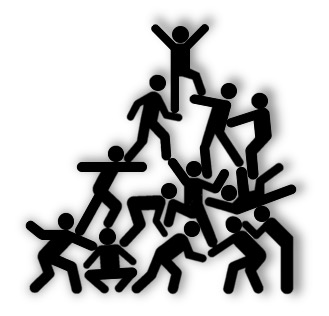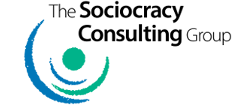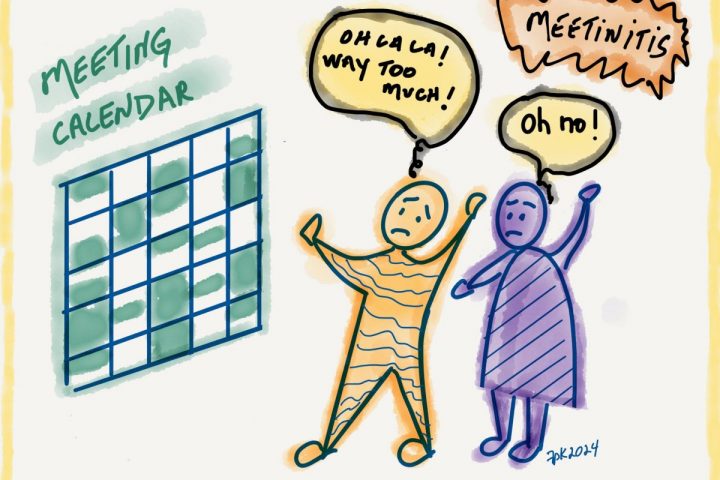 This is the second in a three-part series, and is an excerpt from a white paper by the same title.
This is the second in a three-part series, and is an excerpt from a white paper by the same title.
Part 1 listed two pitfalls of a top-down organization: (1) one-way communication, and (2) decision bottlenecks. Here are two more.
Pitfall #3. Management and workers become adversaries.
We all know of companies where relations between management and workers are less than optimal. A company can lose collaborative creativity and a lot of time and money settling disputes. In extreme cases, when management and workers take sides on a polarized issue, workers might even strike.
In the Sociocratic Circle Method (SCM), management and workers make policy decisions collaboratively and transparently, joining forces to devise solutions that will work for everyone. Both meetings and method of decision-making are designed so that all voices are heard, and to help the group jointly craft new solutions. Part 1 of this series discussed the decision-making method when setting policy, and Part 3 will discuss more about meetings. In The Netherlands, where the SCM originated, the law requires companies with 30 or more employees to have a workers council, similar to an in-house labor union in the U.S. This requirement is waived for companies run sociocratically, because the SCM creates a collaborative relationship between management and workers and protects workers’ interests better than the councils (Buck & Villines, 2017).
Case Study
Endenburg Electrotechniek, an electrical engineering company in Rotterdam, Netherlands, designs, manufactures, and installs heavy-duty electrical equipment. In the late 1970’s, a local shipyard suddenly shut down, unable to keep up with competition from the Japanese shipbuilding industry. That wiped out almost all of Endenburg’s Boat Department’s business overnight, and the Board decided to begin laying off most of the Boat Department. A machinist in the Assembly Department had an idea for another solution – to send the members of the Boat Department out in suits and ties and bring in the Sales Department to give them some crash sales training. His idea went through the linked circles [see Part 1 in this series] quickly; the Board made a few adjustments to the proposal and consented to it. Three weeks later the company had enough new business that they cancelled most of the layoffs, and the company diversified its customer base and was stronger. The company still exists today. (Buck & Endenburg, 2012; Buck & Villines, 2017.)
Pitfall #4. Workers disengage.
According to a 2018 Gallup poll, only 34% of workers in the U.S. feel engaged, while 53% of workers do not feel engaged (Harter, 2018). This represents a huge loss both to companies and to all the individuals involved, since engaged workers are more creative and productive and lead more fulfilling lives. In the SCM, those doing the work in any part of the organization make decisions about how they do the work. Employees who feel their voices are heard are 4.6 times more likely to feel empowered to perform their best work (Beheshti, 2019). Similarly, employees involved in decision-making are more engaged (Stark, 2010; Whitehurst, 2016). And organizations with engaged employees outperform those with low employee engagement by a whopping 202% (Kanapi, 2017).
User Comment
“We adopted sociocracy and all of a sudden there is a room full of empowered people helping make decisions. People feel different. I’d say that at the end of 100% of our circle meetings – where we set policy – everyone says, ‘My goodness. I feel so much more energized.’ We have fewer meetings over time as we’ve implemented sociocracy, the decisions are better, and the follow-through is better because everyone’s on board.”
– Paul Kervick, Outreach Coordinator and Board Member, Living Well Residential Care Home & Assisted Living, Bristol, Vermont, using Sociocracy since 2004
This part of “5 Pitfalls of a Top-Down Hierarchy and What to Do About Them” describes how management and workers can become adversaries in a top-down hierarchy, and how workers can disengage when they are outside the decision-making process. It also describes the benefits of collaborative decision-making when everyone in the organization is involved. Next, part 3 in the series will describe an additional pitfall, that of the organization losing information and creativity with solely top-down hierarchy, and how putting all the pieces together makes it possible to steer an organization collectively.
Thanks to Sharon Villines and Erin Young for editing assistance with this series.
Sources
- Naz Beheshti, 2019, “10 Timely Statistics About The Connection Between Employee Engagement And Wellness.”
- John A. Buck and Gerard Endenburg, 2012, “The Creative Forces of Self-Organization.”
- John Buck and Sharon Villines, 2017, We the People: Consenting to a Deeper Democracy, 2nd edition. Washington, DC: Sociocracy.info.
- Jim Harter, 2018, “Employee Engagement on the Rise in the U.S.” Gallup News.
- Henry Kanapi, 2017, “15 Employee Engagement Statistics That You Should Know.”
- Peter Barron Stark, 2010, “6 Reasons to Involve Employees in Decision Making.”
- Jim Whitehurst, 2016, “Decisions Are More Effective When More People Are Involved from the Start,” Harvard Business Review.
 Sheella Mierson, Ph.D., a founding member of The Sociocracy Consulting Group, consults with organizations to clarify business objectives and create adaptive structures and processes to achieve them. Contact us for a free consultation.
Sheella Mierson, Ph.D., a founding member of The Sociocracy Consulting Group, consults with organizations to clarify business objectives and create adaptive structures and processes to achieve them. Contact us for a free consultation.



